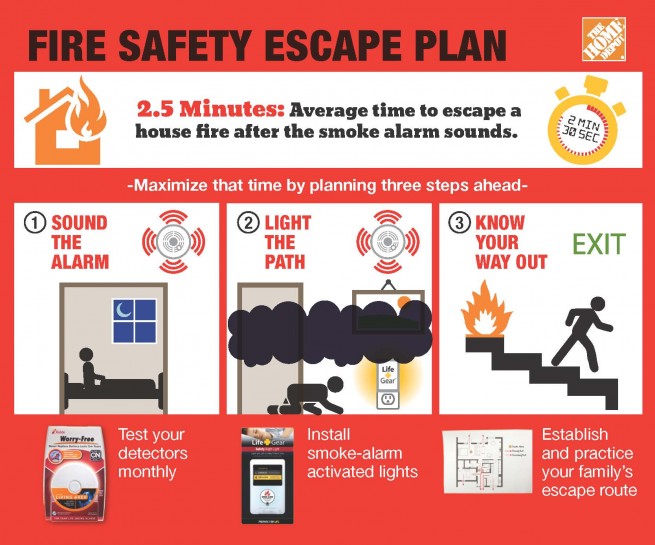An exit route is made up of three components: Other requirements that apply to exit routes include the following: Recommended OSHA has very specific requirements for emergency exits in the
Exit Routes At Work – The Safety Brief
LO 1.1.1. Describe employer and employee responsibilities under the Fire Prevention Program (FPP), the components of a FPP, and associated procedures. LO 1.2.1. Describe workplace fire hazards, hazard control methods, and flammable/combustible materials. LO 1.3.1. Describe the purpose of fixed extinguishing systems and identify their components.

Source Image: trektravel.com
Download Image
Exit Routes In order to ensure safe and timely evacuation in an emergency situation, exit routes must follow strict criteria. Exit routes must be adequately signposted, exit to an outside area, be unlocked, be sufficiently large, as well as being sufficient for the number of people needing to exit during an emergency.

Source Image: bhadrafiresafety.blogspot.com
Download Image
Exit routes: Navigating Exit Routes: Ensuring Safe Use and Occupancy – FasterCapital
Exit routes must meet the following design and construction requirements: (1) An exit route must be permanent. Each exit route must be a permanent part of the workplace. (2) An exit must be separated by fire resistant materials.

Source Image: seechange.com
Download Image
Why Must Exit Routes Follow Strict Criteria
Exit routes must meet the following design and construction requirements: (1) An exit route must be permanent. Each exit route must be a permanent part of the workplace. (2) An exit must be separated by fire resistant materials.
1. Exit routes are designed to provide a safe and efficient means of escape in the event of an emergency, such as a fire or other hazardous situation. Step 2/6 2. To ensure that exit routes are effective, they must follow strict criteria that are established by various safety codes and regulations. Step 3/6 3.
Exit routes in the workplace
Exit routes are sometimes referred to as “means of egress” and are covered under OSHA standards 1910.36 (“Design and construction requirements for exit routes“) and 1910.37 (“Maintenance, safeguards, and operational features for exit routes).
Premium Vector | Emergency fire exit sign evacuation fire escape door emergency exit concept arrow for exit route

Source Image: freepik.com
Download Image
Network Urge | An Urge To Learn
Exit routes are sometimes referred to as “means of egress” and are covered under OSHA standards 1910.36 (“Design and construction requirements for exit routes“) and 1910.37 (“Maintenance, safeguards, and operational features for exit routes).

Source Image: networkurge.com
Download Image
Exit Routes At Work – The Safety Brief
An exit route is made up of three components: Other requirements that apply to exit routes include the following: Recommended OSHA has very specific requirements for emergency exits in the

Source Image: safetybrief.creativesafetysupply.com
Download Image
Exit routes: Navigating Exit Routes: Ensuring Safe Use and Occupancy – FasterCapital
Exit Routes In order to ensure safe and timely evacuation in an emergency situation, exit routes must follow strict criteria. Exit routes must be adequately signposted, exit to an outside area, be unlocked, be sufficiently large, as well as being sufficient for the number of people needing to exit during an emergency.

Source Image: fastercapital.com
Download Image
Pro Cycling Crashes – The Sport of Cycling Fetishizes Pain Too Much
Nov 7, 2023An exit route, according to NFPA 101 Life Safety Code, is a continuous and unobstructed path of vertical or horizontal egress travel from any point in a building or facility to a public way. In most cases, exit routes have three characteristics. First, they are continuous—they do not end at intermediate points within a structure.

Source Image: bicycling.com
Download Image
They Get Fired All the Time. And They Have No Idea Why.’
Exit routes must meet the following design and construction requirements: (1) An exit route must be permanent. Each exit route must be a permanent part of the workplace. (2) An exit must be separated by fire resistant materials.

Source Image: institutionalinvestor.com
Download Image
Exit routes very important | PPT
1. Exit routes are designed to provide a safe and efficient means of escape in the event of an emergency, such as a fire or other hazardous situation. Step 2/6 2. To ensure that exit routes are effective, they must follow strict criteria that are established by various safety codes and regulations. Step 3/6 3.

Source Image: slideshare.net
Download Image
Network Urge | An Urge To Learn
Exit routes very important | PPT
LO 1.1.1. Describe employer and employee responsibilities under the Fire Prevention Program (FPP), the components of a FPP, and associated procedures. LO 1.2.1. Describe workplace fire hazards, hazard control methods, and flammable/combustible materials. LO 1.3.1. Describe the purpose of fixed extinguishing systems and identify their components.
Exit routes: Navigating Exit Routes: Ensuring Safe Use and Occupancy – FasterCapital They Get Fired All the Time. And They Have No Idea Why.’
Nov 7, 2023An exit route, according to NFPA 101 Life Safety Code, is a continuous and unobstructed path of vertical or horizontal egress travel from any point in a building or facility to a public way. In most cases, exit routes have three characteristics. First, they are continuous—they do not end at intermediate points within a structure.